Mold in Window AC Unit? How to Clean, Inspect, and Prevent It
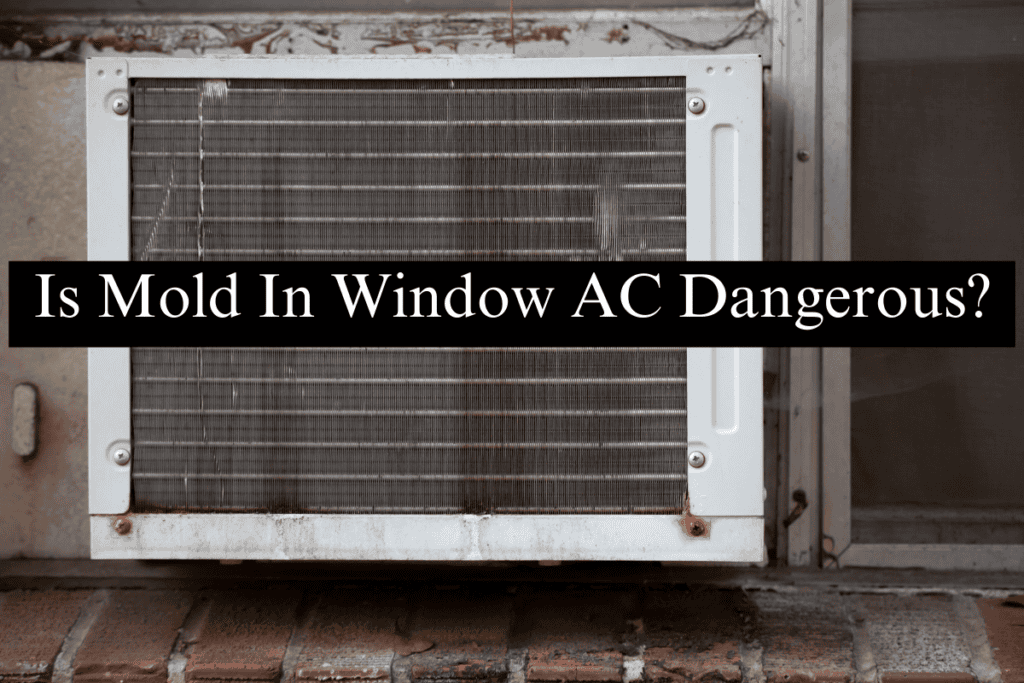
Have you noticed a musty smell coming from your window AC unit? It could be a sign of mold growth inside your air conditioner.
Inhaling or touching mold or mold spores can trigger asthma symptoms, including shortness of breath, wheezing, or coughing in people with known allergies.
Even those without allergies can experience irritation, muscle aches, chills, fever, night sweats, and profound fatigue, according to the Centers for Disease Control and Prevention (CDC).
Mold in your window air conditioner can pose serious health risks, making it crucial to address the issue promptly. Black mold, in particular, can be dangerous and should be removed as soon as possible.
The presence of mold spores in your AC unit can spread throughout your home, compromising indoor air quality and potentially causing health problems for you and your family.
In this article, we will discuss how to identify mold buildup in your window unit, the steps to clean mold effectively, and the preventive measures you can take to minimize the risk of mold in the future.
We’ll also cover the importance of regular maintenance and cleaning of your air conditioning unit to ensure it continues to provide cool, clean air for your home.
Contents
- 1 Why is There Mold in A Window AC Unit?
- 2 Is Mold in Window AC Dangerous?
- 3 How To Tell If There’s Mold in Your AC Unit
- 4 How to Clean Mold from Your Window AC Unit at Home: 9 Steps
- 5 Preventing Mold in A Window Air Conditioner Unit
Why is There Mold in A Window AC Unit?
Mold requires three key elements to grow: moisture, warmth, and organic matter. Unfortunately, window units provide an ideal environment for mold buildup due to their tendency to accumulate condensation.
This moisture, combined with the warm air circulating through the unit and the presence of dust and other organic particles, creates a perfect breeding ground for mold.
If you live in a humid state like Florida, it’s crucial to regularly check your window air conditioner for signs of mold. Lack of maintenance and infrequent cleaning can also contribute to the problem, as dust and debris can block airflow and trap moisture within the unit.
In some cases, water damage in your house might have caused mold to spread to your AC unit and other areas like basements.
Even newer window-mounted AC models can be susceptible to mold buildup, as they may not effectively drain the water that collects inside.
To combat this issue, some homeowners choose to drill small holes into the bottom pan of their window units to allow for proper drainage.
While this may slightly reduce the unit’s efficiency, it’s a preferable alternative to having mold spores circulated throughout your home.
Regular cleaning and maintenance of your window air conditioner at the end of each season can significantly reduce the risk of molding.
By taking apart the unit and thoroughly washing it with soap and a stiff brush, you can remove any accumulated mold and prevent it from spreading further.
Is Mold in Window AC Dangerous?
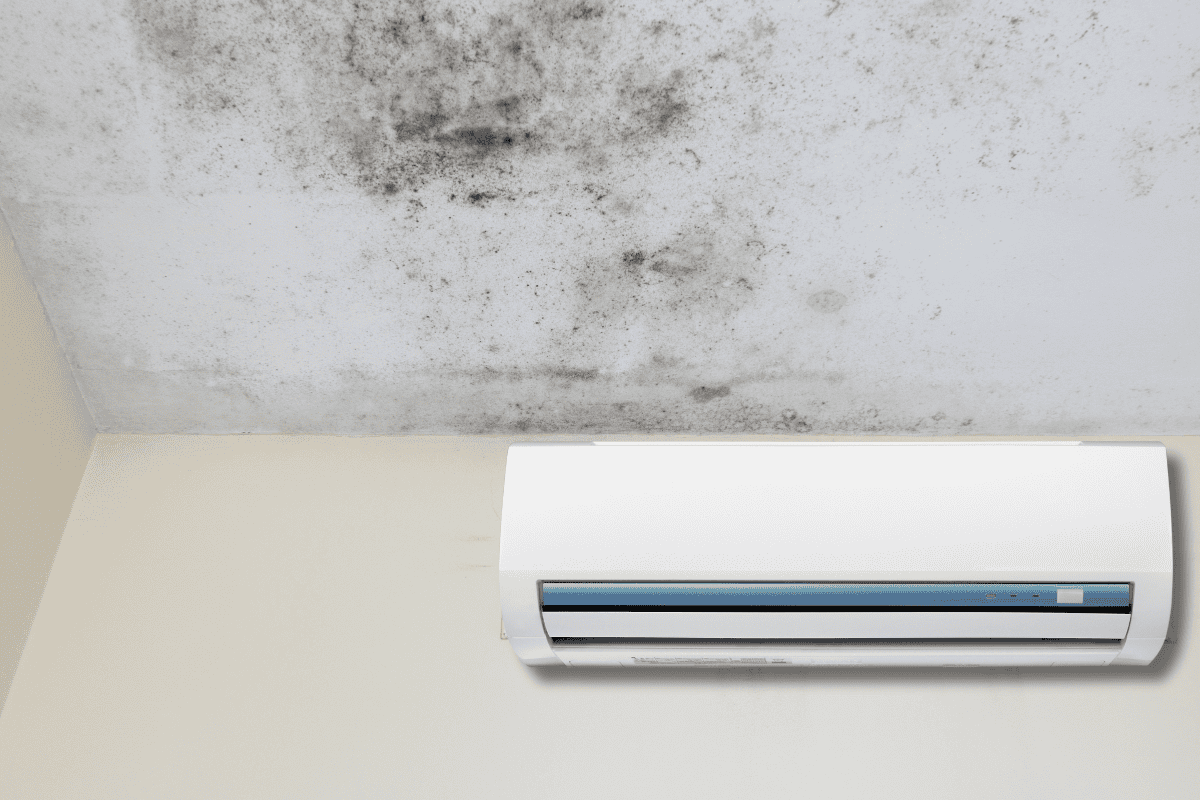
Mold in your window air conditioner can pose serious health risks. When mold grows in your AC unit, it can release mold spores into the air, which can cause allergic reactions, asthma attacks, and other respiratory issues.
In addition to these immediate health concerns, exposure to mold spores can also lead to long-term health problems, such as neurological disorders, according to a study published in the journal, Frontiers in Neurology.
Some types of mold, like black mold, are particularly toxic and require professional remediation. If you suspect that your window unit has black mold, it’s essential to address the problem immediately and avoid using the unit until it has been properly cleaned or replaced.
Growth of mold in your air conditioner can also impact its efficiency. As mold accumulates on the coils and other components, your AC unit has to work harder to cool your space, using more energy and potentially leading to higher utility bills.
Given the potential health risks and the impact on your air conditioner’s performance, it’s crucial to address any mold issues promptly.
Regular cleaning and maintenance of your window-mounted AC can help prevent mold growth, but if you do discover mold, it’s essential to take action quickly to protect your health and the longevity of your unit.
How To Tell If There’s Mold in Your AC Unit
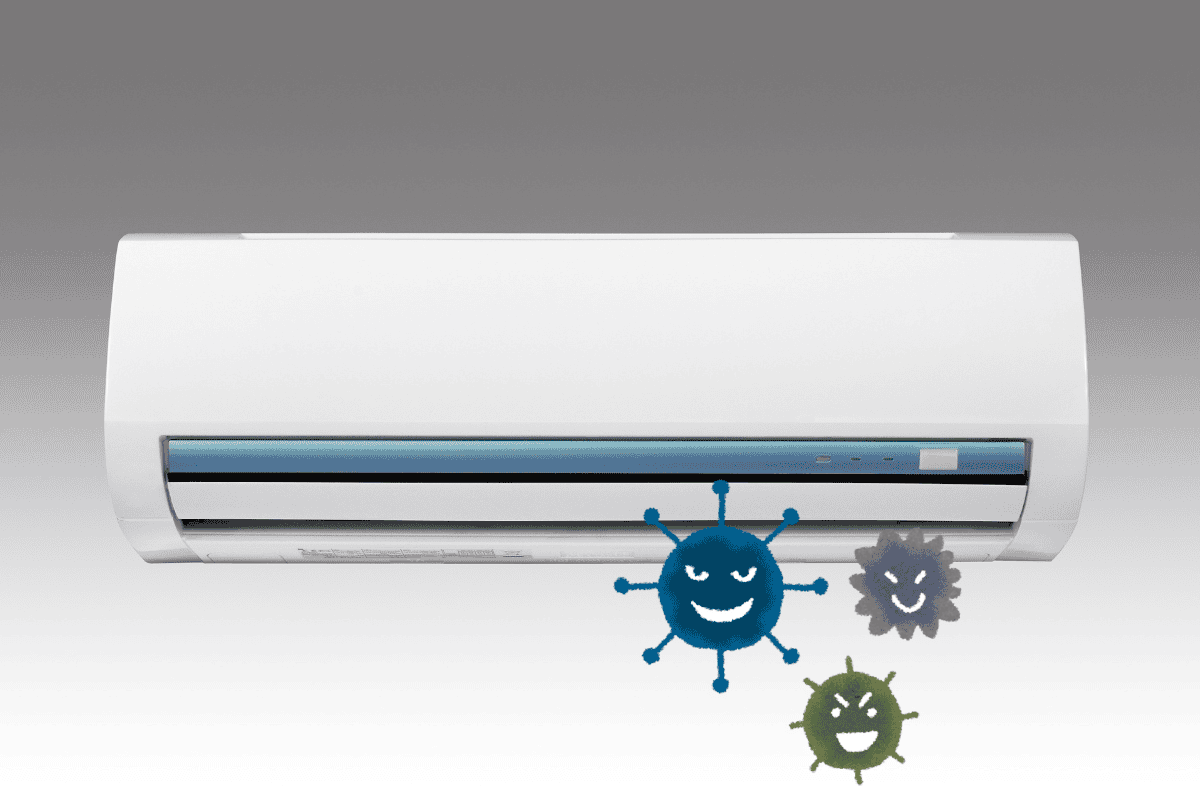
Identifying mold in your window air conditioner isn’t always easy, unless there’s visible mold on the exterior of the unit. Here are some signs to look out for:
1. Musty smell
- One of the most common signs of mold in your AC is a musty smell that’s only noticeable when the unit is running.
- This odor is a clear indication that there may be hidden mold growing inside your air conditioner.
2. Visible signs of mold
- Look for discoloration or fuzzy growths on the surfaces of your window unit.
- If you can’t see any signs on the surface of the unit, it’s important to thoroughly inspect the inside of the unit.
3. Inspecting the interior components
- Remove the grille of your AC and examine the interior components.
- Pay close attention to the air filter, evaporator coils or plates, and drain pan, as these areas are prone to moisture buildup.
4. New or worsening respiratory symptoms
- If someone in your household experiences new or worsening respiratory symptoms, such as coughing, wheezing, or shortness of breath, it may be related to mold exposure.
- Consider the possibility of mold in your AC if these symptoms coincide with the use of your window air conditioner, although these symptoms can have various causes.
How to Clean Mold from Your Window AC Unit at Home: 9 Steps
Method 1: Do It Yourself
If you’ve discovered mold in your window air conditioner, it’s essential to clean it thoroughly to prevent health risks and ensure your unit’s efficiency.
Prerequisites for Window AC Mold Removal

Before you begin cleaning mold from your window air conditioner, it’s essential to gather all the necessary supplies. Here’s a list of items you’ll need:
- White vinegar
- Baking soda
- Hydrogen peroxide
- Scrub brushes
- Rags or sponges
- Gloves
- Mask
- Eye protection
- Screwdriver
- Vacuum cleaner
- Water
Mold Removal From Air Conditioner Safety Tips
When dealing with mold, it’s crucial to prioritize your safety. Here are some essential safety tips to keep in mind:
1. Wear protective gear: Wearing protective gear like rubber gloves, face mask or respirator and goggles will protect you from cleaning solution splashes and airborne mold spores.
2. Work in a well-ventilated area: Working in a well-ventilated area will minimize the risk of moldy air into your home.
3. Dispose of moldy materials properly: After cleaning, the moldy particles should be sealed in a plastic bag to prevent mildew spores from spreading.
4. One cleaning product: Stick to using one cleaning product at a time, as mixing different chemicals can create toxic fumes that are harmful for your health.
Follow these steps to get rid of mold from your window AC:
1. Unplug the Unit
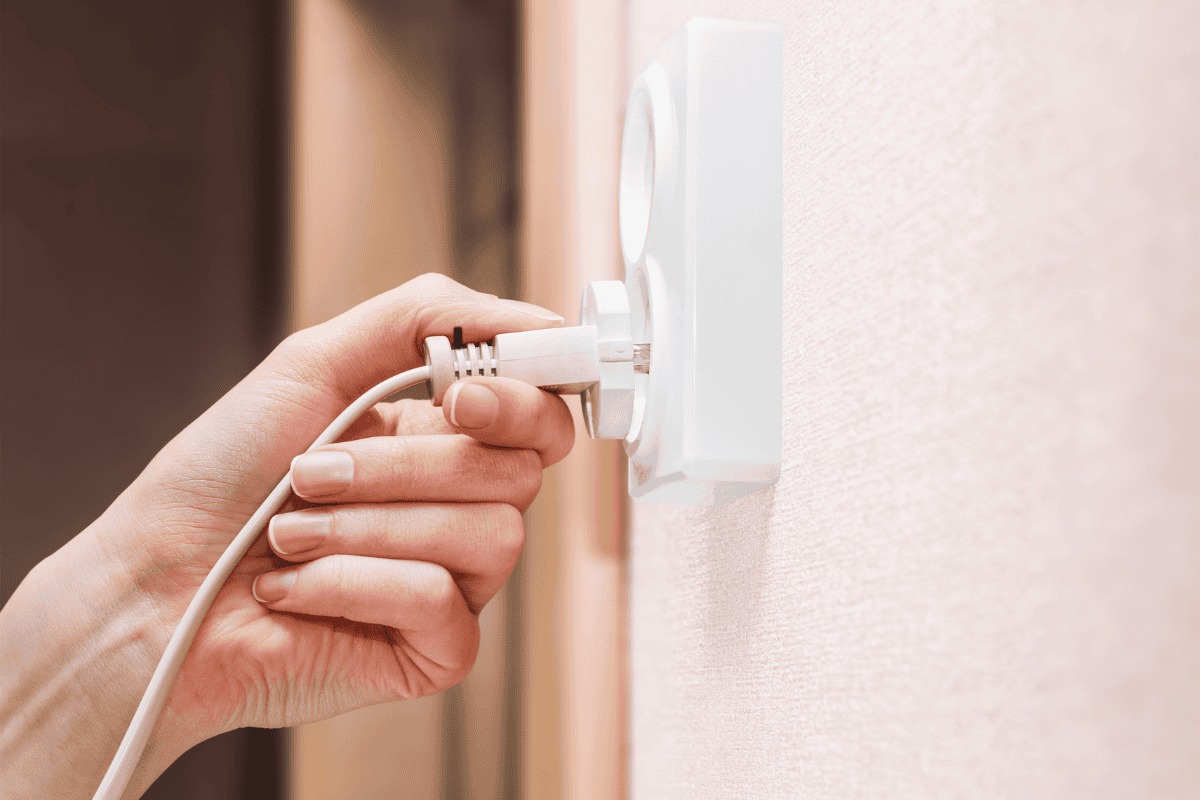
- Locate the power cord and unplug it from the electrical outlet.
- If the unit is hardwired, turn off the power at the circuit breaker.
- Ensure the unit is completely disconnected from the power source before proceeding.
2. Remove the Unit from the Window
- Remove any securing brackets or screws that hold the unit in place.
- Carefully lift the unit from the window, ensuring you have a firm grip on both sides.
- Place the unit on a stable, flat surface, such as a table or workbench.
3. Disassemble the Unit
- Consult your unit’s manual for specific instructions on disassembly.
- Use a screwdriver to remove the front grille, which is usually held in place by clips or screws.
- Take out the filter and set it aside for cleaning.
- Locate the evaporator plates and drain pan, which are typically accessible after removing the front grille.
4. Vacuum Loose Debris
- Use a vacuum cleaner with a brush attachment to get rid of dust, dirt, and debris from the unit’s interior.
- Vacuum the evaporator plate, drain pan, and any other visible surfaces.
- Be gentle when vacuuming to avoid damaging the delicate components.
5. Clean the Filter
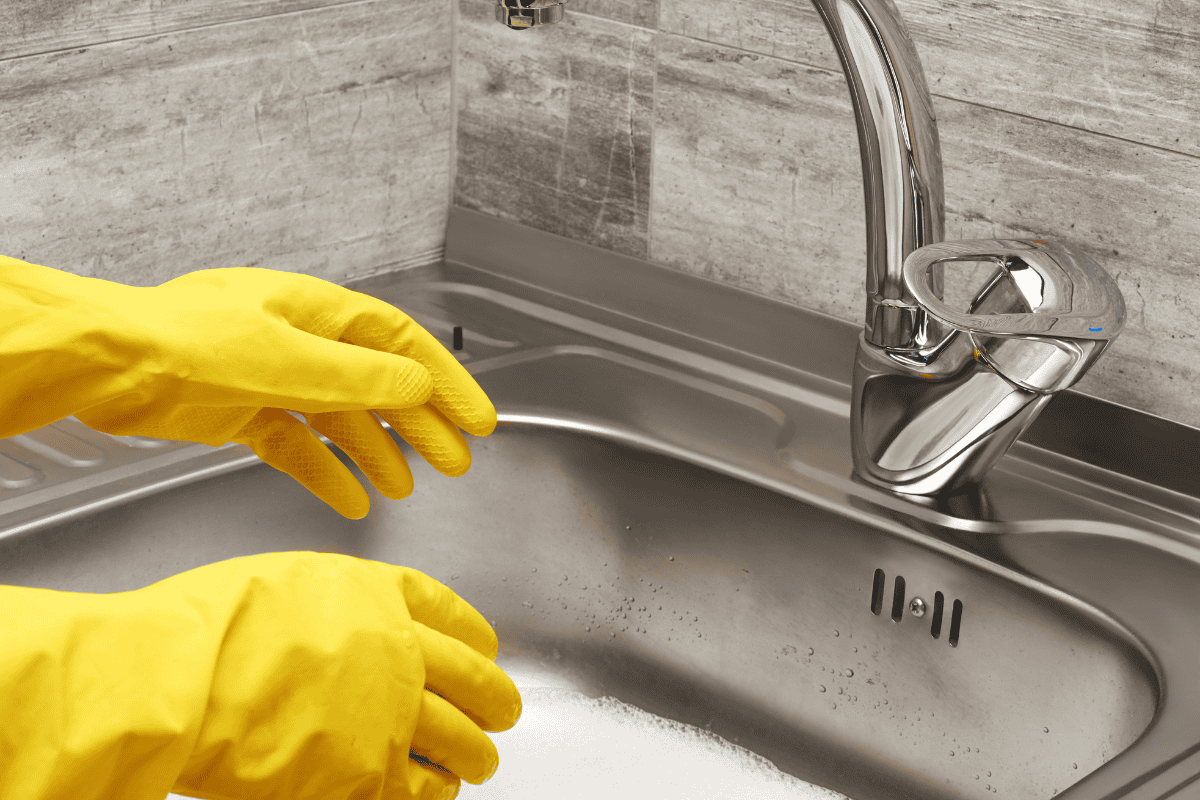
- Fill a sink or basin with warm, soapy water.
- Submerge the filter in the water and use a scrub brush to clean the mold, mildew, and dirt.
- Rinse the filter thoroughly under running water to remove all soap residue.
- Set the filter aside to air dry completely before reinstalling it in front of the unit.
6. Clean the Evaporator Coils
- Mix equal parts water and white vinegar in a spray bottle. You can also use bleach instead of white vinegar but bleach has to be handled carefully as it can be toxic.
- Spray the solution generously onto the evaporator units, making sure to cover all surfaces.
- Allow the solution to sit for 5-10 minutes to help break down mold and grime.
- Use a soft-bristled brush to scrub the plates gently, being careful not to bend or damage them.
- Wipe the condenser coils clean with a damp cloth to remove any remaining debris.
7. Clean the Drain Pan
- Locate the drain pan, which collects condensation from the evaporator plates.
- Remove any standing water from the pan using a sponge or cloth.
- Spray the water and vinegar solution onto the drain pan and scrub it thoroughly with a brush to get rid of mold and ensure proper drainage.
- Wipe the pan clean with a damp cloth.
8. Disinfect with Hydrogen Peroxide
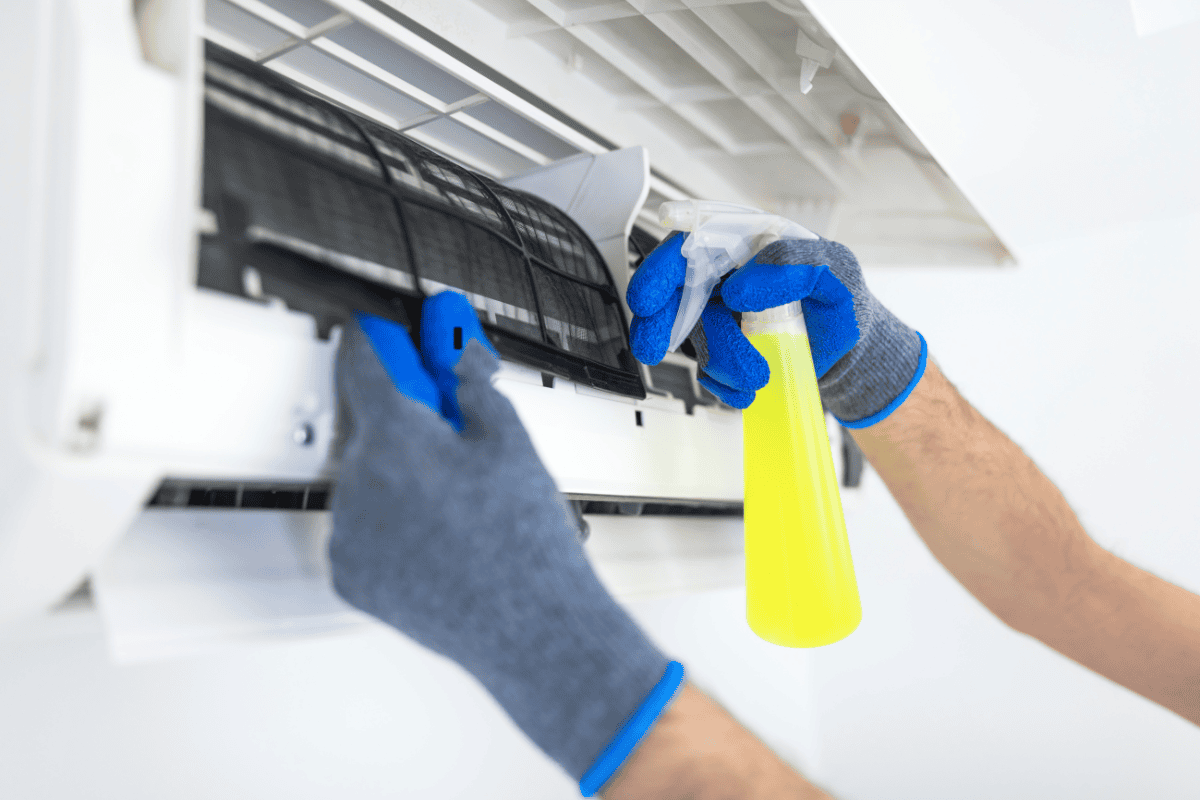
- Fill a clean spray bottle with 3% hydrogen peroxide solution to remove the mold.
- Spray the solution onto the evaporator units, drain pan, and other interior surfaces.
- Allow the hydrogen peroxide to sit for 10-15 minutes to disinfect the unit and prevent future mold buildup.
- Wipe down the surfaces with a clean, damp cloth to remove any excess hydrogen peroxide and clean the unit thoroughly.
9. Reassemble and Dry
- Allow all components to air dry for at least 24 hours, before reassembling the unit.
- Once everything is dry, reassemble the unit, starting with the filter and front grille.
- Make sure all parts are securely in place and the grille is properly attached.
- Plug the unit back in or turn on the power at the circuit breaker.
- Run the unit in a well-ventilated area for a few hours to ensure any remaining moisture is removed and to check for proper functioning.
METHOD 2: Use Mold Killers
If you don’t have enough time to engage in the lengthy process of cleaning mold by yourself, don’t worry you can use EPA approved mold killers.
These products require no scrubbing and act immediately. They also remove stubborn moldy stains.
All you have to do is to spray them on the infected area, wait for a 2-3 minutes and then wipe clean. The best products for killing mold have concrobium in them.
Preventing Mold in A Window Air Conditioner Unit
Preventing mold growth in your window-mounted AC unit is crucial for maintaining a healthy home environment and ensuring your air conditioner operates efficiently. Here are some tips to help you prevent mold:
1. Establish a regular cleaning and maintenance schedule
- Clean your window air conditioner at least once a year, preferably before the start of the cooling season.
2. Use a dehumidifier and ensure proper ventilation
- Reducing moisture levels in the room makes it less likely for mold to grow in your AC unit.
- According to the Centers for Disease Control and Prevention, humidity should be lower than 50% in your home to create an environment that is less conducive to mold buildup.
3. Ensure proper insulation and seal air leaks
- Minimize the amount of warm, moist air that enters your home to reduce the likelihood of mold in your air conditioner and other areas of your house.
4. Avoid turning your AC on and off frequently
- Frequent on and off cycles can allow moisture and warmth to accumulate in the unit, creating the perfect conditions for mold to thrive.
- Use your AC’s auto setting, which will cycle the air conditioner on whenever it detects the need to cool the air, helping keep the front of the unit dry and preventing mold growth while saving you money on energy costs.
Get A Professional’s Assistance
At HVAC Angel, we understand that while many homeowners can successfully clean and maintain their window-mounted AC units to prevent mold growth, there are situations where it’s best to seek professional help to ensure that mold may thoroughly be removed.
If you’re dealing with severe or recurring mold issues in your air conditioner, or if you suspect that the mold has spread to other areas of your home, it’s time to call in our HVAC expert technicians.
Our professional mold remediation team has specialized equipment, training, and expertise to effectively remove mold and prevent its regrowth. We can thoroughly assess the extent of the mold problem in your window AC and develop a comprehensive plan to address it.
This may involve advanced cleaning techniques, the use of commercial-grade disinfectants, and the implementation of preventive measures to ensure mold doesn’t return.
By combining regular maintenance and cleaning with professional help from us when needed, you can keep your window air conditioner mold-free and enjoy a cool, healthy home environment.
Contact us today to learn more about our mold remediation services for your window AC unit.
Frequently Asked Questions About Air Conditioners
1. What are the signs of mold growth in an AC unit?
If you notice a mold and mildew like odor, visible mold spots, or experience recurring allergies while the air conditioner is running, these could be indications of mold growth within the AC unit and an indication that it’s time to clean a window air conditioner.
2. How can I prevent mold in my air conditioning unit?
To prevent mold in your air conditioning unit, regularly clean the interior of the unit air filter, maintain proper indoor air quality, and ensure proper airflow by keeping the unit clean and dry.
3. Can mold in an AC unit affect air quality?
Yes, mold in an AC unit can degrade air quality by releasing mold particles into the air of your home which can trigger allergies and respiratory issues.
4. When should I suspect mold growth in my AC unit?
If you notice musty odors, visible mold spots, or if individuals in the house experience unexplained health issues like allergies or respiratory problems, there is something wrong.
